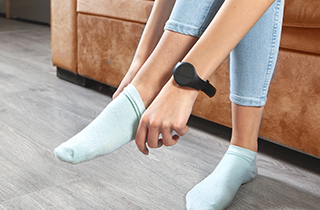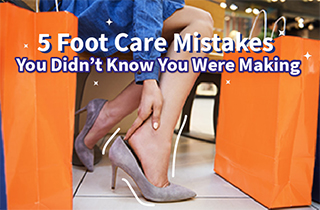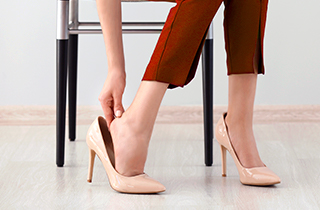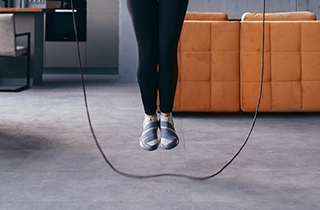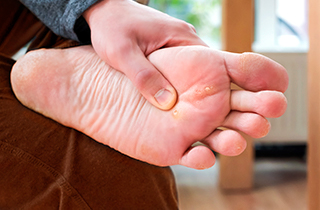
Noticed an odd skin growth on your foot? Warts and corns can be confusing to differentiate without the right information. However, the good news? They can both be cured. Despite their similarities, corns and warts signify different issues and require separate prevention.
What are Corns?
Corns develop due to prolonged exposed rubbing or pressure on areas of the foot. They are painful especially when walking or due to pressure when standing. Their characteristics include a raised surface and a hard formation which is yellow-beige in color surrounded by dry, flaky skin (Corns: Overview, 2009).
Causes of Corns
The formation of corns can come from daily activities such as long hours of standing and walking, as well as wearing ill-fitting or unsuitable footwear (Corns and Calluses, 2019). Not only that, bad walking posture or any deformities in the foot and leg are more likely to have corns developing due to extra friction on the foot while walking.
Curing and Preventing Corns
To cure or prevent corn, one can start with the position of the occuring corn. Check your footwear fit; if it is too tight on certain areas, it is likely to be causing the formation (How to Treat Corns and Calluses, n.d.). Alternatively, you may also check your posture by standing or walking in front of a mirror.
Another question you can ask yourself as well: are you putting more pressure on one foot? You can tell by the wear and tear of your shoe soles, as one side may be more worn out than the other in certain areas (How to Treat Corns and Calluses, n.d.).
What are Warts?
Warts, on the other hand, are a small growth on the skin that may look like a solid blister or a small cauliflower. Their characteristics include a grainy, fleshy appearance with black pinpoints. A cutaneous wart is also called a verruca or papilloma, and warty-looking lesions of any cause may be described as verrucous or papillomatous.
Types of Warts
- Painful verrucae
They appear on the soles of the feet, heels, and toes. - Plane warts
They are round, flat, and smooth. It can be yellowish, brownish, or skin colored. Also known as flat warts, they grow most often in sun-exposed areas. - Filiform warts
These warts are long and thin in shape. They can grow rapidly on the eyelids, neck, and armpits. - Mosaic warts
These are multiple plantar warts in a large cluster.
Warts Causes
Warts are caused by viruses in the human papillomavirus (HPV) family. Papillomaviruses are small, non-enveloped, icosahedral DNA viruses that have a diameter of 52–55 nm. People with weakened immune systems are more likely to develop warts (Human Papillomavirus (HPV) Infection, 2007).
Although they may clear up on their own, it can take from a few weeks to several years, depending on the location and number of warts. Warts or verrucae should be covered up with a waterproof adhesive bandage when swimming. If the wart is gone but the virus remains, warts may still recur.
Curing and Preventing Warts
To prevent a wart, avoid direct contact with the virus. One way is to avoid holding or shaking hands with people who have warts. Another way is to avoid using personal care items of people who have warts, such as nail clippers, nail files, or pumice stones (Brazier, 2017).
Most importantly, if you have a wart, don’t pick at it or bite your fingernails. This can potentially spread the virus to other parts of your body (Robinson, 2019).
If you’re experiencing corns or warts, say goodbye to these painful formations on your feet by using Ellgy Plus Corns & Warts Treatment Solution! It is formulated with Salicylic Acid 17% to break the bonds that hold skin cells together. Restore your feet and heels to their natural glory by getting yours today at pharmacies and health stores nationwide.
References
- Brazier, Y. (2017, November 28). How to treat a wart. Medical News Today. https://www.medicalnewstoday.com/articles/155039#typesCorns and Calluses. (2019, November 12).
- Cleveland Clinic. https://my.clevelandclinic.org/health/diseases/16896-corns-and-callusesCorns: Overview. (2009, April 11).
- NCBI. https://www.ncbi.nlm.nih.gov/books/NBK541153/How to treat corns and calluses. (n.d.).
- American Academy of Dermatology Association. Retrieved from https://www.aad.org/public/everyday-care/injured-skin/burns/treat-corns-calluses
- Human Papillomavirus (HPV) Infection. (2007). NCBI. https://www.ncbi.nlm.nih.gov/books/NBK321770/
- Robinson, J. (2019, September 10). Visual Guide to Warts. WebMD. https://www.webmd.com/skin-problems-and-treatments/ss/slideshow-warts
